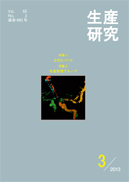Volume 65, Issue 3
Displaying 1-19 of 19 articles from this issue
- |<
- <
- 1
- >
- >|
Introduction to Special Section
-
2013Volume 65Issue 3 Pages 255
Published: May 01, 2013
Released on J-STAGE: September 06, 2013
Download PDF (605K)
Research Review
-
2013Volume 65Issue 3 Pages 257-261
Published: May 01, 2013
Released on J-STAGE: September 06, 2013
Download PDF (1002K)
Research Flash
-
2013Volume 65Issue 3 Pages 263-265
Published: May 01, 2013
Released on J-STAGE: September 06, 2013
Download PDF (1112K)
Research Review
-
2013Volume 65Issue 3 Pages 267-271
Published: May 01, 2013
Released on J-STAGE: September 06, 2013
Download PDF (594K)
Research Flash
-
2013Volume 65Issue 3 Pages 273-280
Published: May 01, 2013
Released on J-STAGE: September 06, 2013
Download PDF (644K) -
2013Volume 65Issue 3 Pages 281-284
Published: May 01, 2013
Released on J-STAGE: September 06, 2013
Download PDF (764K)
Introduction to Special Section
-
2013Volume 65Issue 3 Pages 285
Published: May 01, 2013
Released on J-STAGE: September 06, 2013
Download PDF (155K)
Research Review
-
2013Volume 65Issue 3 Pages 287-294
Published: May 01, 2013
Released on J-STAGE: September 06, 2013
Download PDF (1456K)
Research Flash
-
2013Volume 65Issue 3 Pages 295-299
Published: May 01, 2013
Released on J-STAGE: September 06, 2013
Download PDF (722K) -
2013Volume 65Issue 3 Pages 301-305
Published: May 01, 2013
Released on J-STAGE: September 06, 2013
Download PDF (659K) -
2013Volume 65Issue 3 Pages 307-308
Published: May 01, 2013
Released on J-STAGE: September 06, 2013
Download PDF (466K)
Research Review
-
2013Volume 65Issue 3 Pages 309-313
Published: May 01, 2013
Released on J-STAGE: September 06, 2013
Download PDF (470K)
Research Flash
-
2013Volume 65Issue 3 Pages 315-318
Published: May 01, 2013
Released on J-STAGE: September 06, 2013
Download PDF (467K)
Research Review
-
2013Volume 65Issue 3 Pages 319-323
Published: May 01, 2013
Released on J-STAGE: September 06, 2013
Download PDF (674K)
Research Flash
-
2013Volume 65Issue 3 Pages 325-328
Published: May 01, 2013
Released on J-STAGE: September 06, 2013
Download PDF (603K) -
2013Volume 65Issue 3 Pages 329-335
Published: May 01, 2013
Released on J-STAGE: September 06, 2013
Download PDF (1573K) -
2013Volume 65Issue 3 Pages 337-342
Published: May 01, 2013
Released on J-STAGE: September 06, 2013
Download PDF (2849K) -
2013Volume 65Issue 3 Pages 343-346
Published: May 01, 2013
Released on J-STAGE: September 06, 2013
Download PDF (1047K)
Research Paper
Research Flash
-
2013Volume 65Issue 3 Pages 347-348
Published: May 01, 2013
Released on J-STAGE: September 06, 2013
Download PDF (360K)
- |<
- <
- 1
- >
- >|
